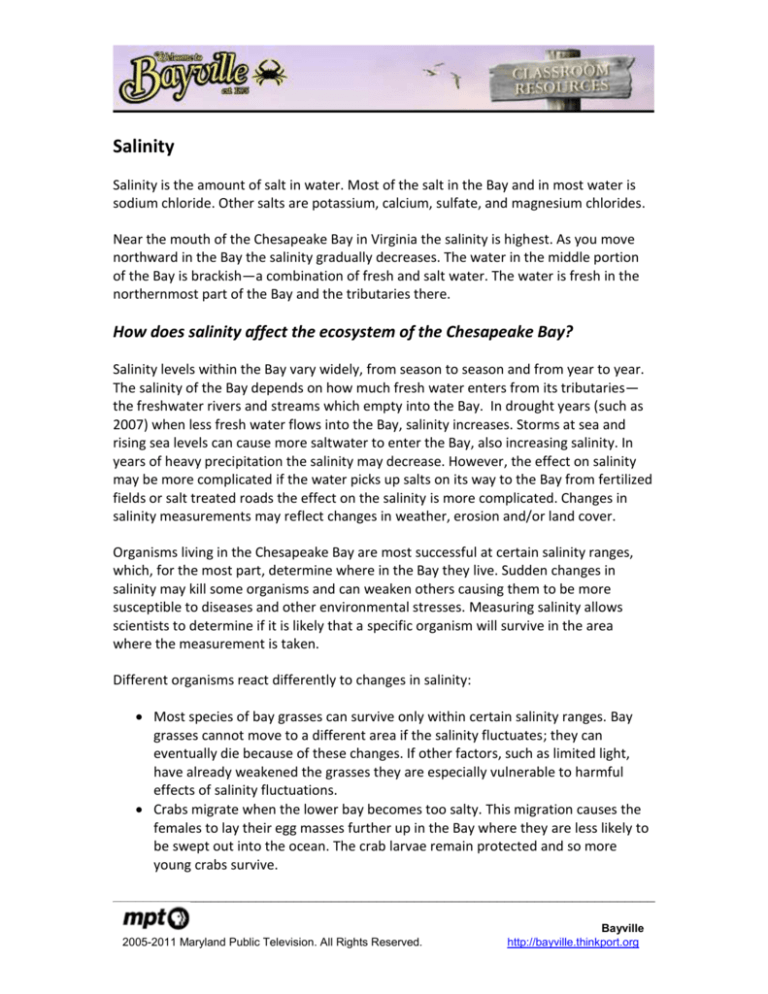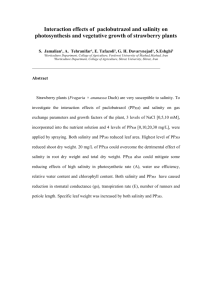
Salinity
Salinity is the amount of salt in water. Most of the salt in the Bay and in most water is
sodium chloride. Other salts are potassium, calcium, sulfate, and magnesium chlorides.
Near the mouth of the Chesapeake Bay in Virginia the salinity is highest. As you move
northward in the Bay the salinity gradually decreases. The water in the middle portion
of the Bay is brackish—a combination of fresh and salt water. The water is fresh in the
northernmost part of the Bay and the tributaries there.
How does salinity affect the ecosystem of the Chesapeake Bay?
Salinity levels within the Bay vary widely, from season to season and from year to year.
The salinity of the Bay depends on how much fresh water enters from its tributaries—
the freshwater rivers and streams which empty into the Bay. In drought years (such as
2007) when less fresh water flows into the Bay, salinity increases. Storms at sea and
rising sea levels can cause more saltwater to enter the Bay, also increasing salinity. In
years of heavy precipitation the salinity may decrease. However, the effect on salinity
may be more complicated if the water picks up salts on its way to the Bay from fertilized
fields or salt treated roads the effect on the salinity is more complicated. Changes in
salinity measurements may reflect changes in weather, erosion and/or land cover.
Organisms living in the Chesapeake Bay are most successful at certain salinity ranges,
which, for the most part, determine where in the Bay they live. Sudden changes in
salinity may kill some organisms and can weaken others causing them to be more
susceptible to diseases and other environmental stresses. Measuring salinity allows
scientists to determine if it is likely that a specific organism will survive in the area
where the measurement is taken.
Different organisms react differently to changes in salinity:
Most species of bay grasses can survive only within certain salinity ranges. Bay
grasses cannot move to a different area if the salinity fluctuates; they can
eventually die because of these changes. If other factors, such as limited light,
have already weakened the grasses they are especially vulnerable to harmful
effects of salinity fluctuations.
Crabs migrate when the lower bay becomes too salty. This migration causes the
females to lay their egg masses further up in the Bay where they are less likely to
be swept out into the ocean. The crab larvae remain protected and so more
young crabs survive.
________________________________________________________________________
2005-2011 Maryland Public Television. All Rights Reserved.
Bayville
http://bayville.thinkport.org
For oysters an increase in salinity also can help reproduction but oyster diseases
(such as MSX and Dermo) are more prevalent at higher salinity levels. Mussel
reproduction often decreases as salinity increases.
How can salinity be measured?
One method of measuring salinity is using a conductivity meter. This meter uses the fact
that the higher the salt content of water, the more easily an electric current passes
through it (the better it conducts electricity). The meter measures how well the water
sample conducts electricity and translates it into a salinity measurement.
Salinity is usually measured in PSU (Practical Salinity Units). For our purposes, 1 PSU is
the equivalent of one part per thousand (ppt). If you have 999 teaspoons of water and
you put in one teaspoon of salt the salinity of that water is 1 ppt. (The measurements
are usually made in grams, not teaspoons, but you get the picture.)
Salinity can also be measured using a hydrometer which may be familiar from caring for
fish tanks. Hydrometers determine the density of the water being tested and that is
compared to pure water in order to give a measure of the salt in the water. The more
salt in the water, the more dense the water is.
How to measure salinity with a conductivity meter:
•
•
•
•
Rinse the probe of the meter in the sample.
Make sure the sample is well mixed.
Turn the meter on and allow a minute for it to “warm up”.
Take the salinity reading from the meter.
________________________________________________________________________
2005-2011 Maryland Public Television. All Rights Reserved.
Bayville
http://bayville.thinkport.org







